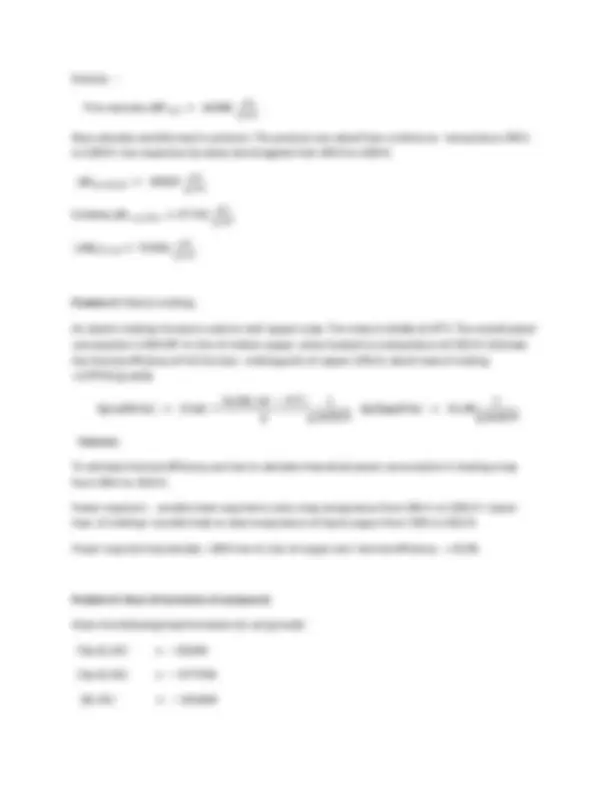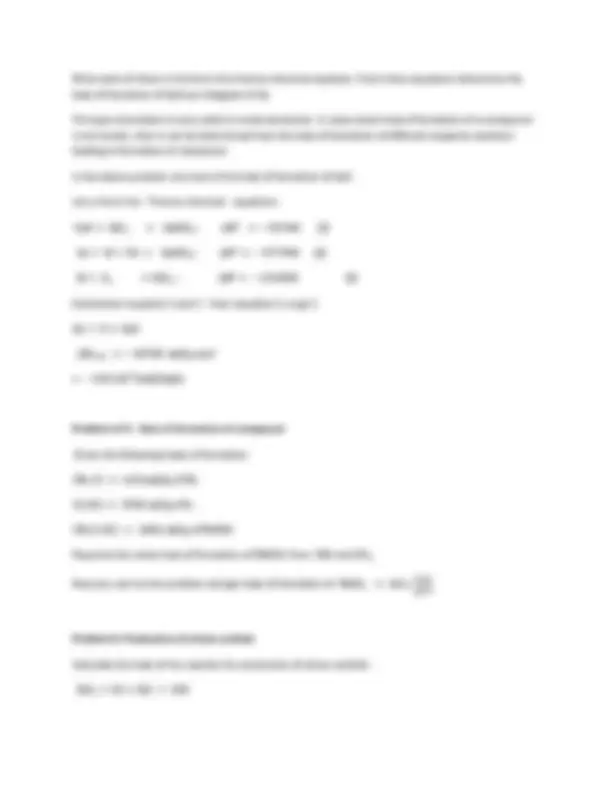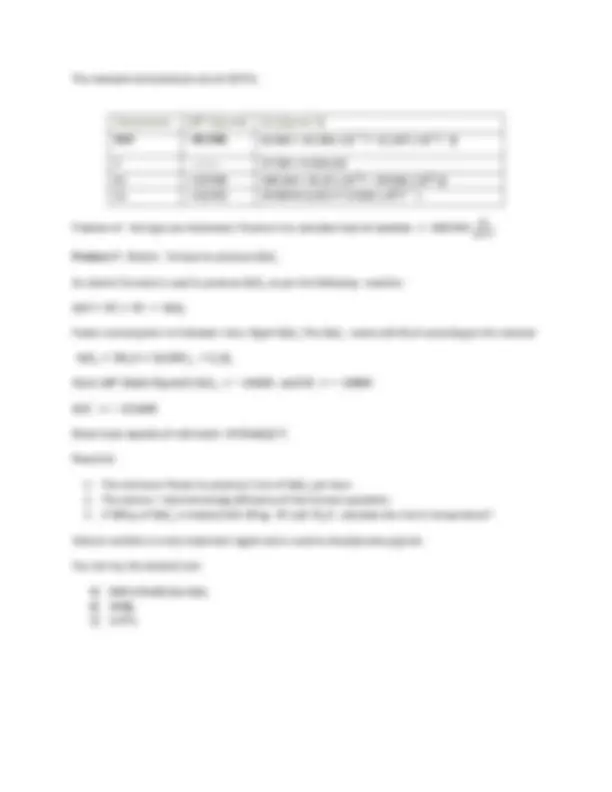





Study with the several resources on Docsity

Earn points by helping other students or get them with a premium plan


Prepare for your exams
Study with the several resources on Docsity

Earn points to download
Earn points by helping other students or get them with a premium plan
Community
Ask the community for help and clear up your study doubts
Discover the best universities in your country according to Docsity users
Free resources
Download our free guides on studying techniques, anxiety management strategies, and thesis advice from Docsity tutors
A series of problems related to thermochemistry applications in metal extraction. The problems cover topics such as carbothermic reduction, heat of reaction, electric melting, and heat of formation of compounds. Students are required to calculate the heat required for various reactions, determine the thermal efficiency of electric melting furnaces, and find the heat of formation of compounds using given data.
Typology: Study notes
1 / 6

This page cannot be seen from the preview
Don't miss anything!




Lecture 8: Thermo chemistry applications in metal extraction Contents Problem 1: Carbothermic reduction Problem 2: Heat of reaction in extraction of Zn Problem 3: Electric melting Problem 4: Heat of formation of compound Problem 5: Heat of formation of compound Problem 6: Production of SiC
Zn ሺSሻ ൌ Zn ሺ1ሻ; Tm ൌ 692.5K; ∆H (^) ୳ୱ୧୭୬ ൌ 1740 cal /g. mole Zn ሺ1ሻ ൌ Zn ሺgሻ; Tm ൌ 1180K; ∆H (^) Vୟ୮ ൌ 275 5 cal /g. mole
ZnOሺSሻ C ሺsሻ ൌ Zn ሺgሻ CO ሺgሻ Reactants are at 298 K and products at 1300 K ሺ∆H (^) R ሻଵଷK ൌ ∆H° (^) ଶଽ଼ ∑ሺHଵଷ െ H (^) ଶଽ଼ ሻp െ ∑ሺHଵଷ െ H (^) ଶଽ଼ ሻR 1
ents ∆H° (Cal/g.mol) Cp (Cal/g.mo K)
Problem8: Hall Heroult cell Problem 9: Heat of formation
Problem 1 : Carbothermic reduction Carbothermic reduction is commonly used to produce metals from oxides. Calculate the heat required (in Kcal/Kg of Zinc) to produce Zinc from reduction of ZnO with carbon.The reactants, ZnO and C, enter at 250 °C , whereas Zinc vapor and CO gas leave at 1027 .use the following data:
6
Compon l. ZnO(S) (^) ‐ 83800 11.71+(1.22 X 10 –^3 T) –(2.18 x 10 5 T ‐^2 )
Solution:
C(S) 0 0.026+(9.307X10‐^3 T)‐ (0.354x10 5 T ‐^2 ) Zn(S) (^0) 5.35+(2.40x10‐^3 T) CO(g) ‐ 26420 6.79+(0.98x10‐^3 T)‐(0.11x10 5 T‐^2 ) Zn(1) ‐‐‐‐ 7. Zn(g) ‐‐‐‐‐‐‐‐ 5.
Reactants are at 298K; hence sensible heat in reactants is zero adopted
Zn ሺ692.5Kሻ ൌ Zn ሺ692.5 Kሻ; Latent heat of fusion, Zn ሺLሻ, 692.5 ൌ Zn ሺlሻ.1180 K sensible heat n ሺ1180ሻ ൌ Zn ሺvሻ ; latent heat of aporation Zn ሺvሻ 1180 K ൌ Zn ሺvሻ 1300K ; Sensible heat.
Sensible heat in CO at 1300K = (^) ଶଽ଼ ଵଷcpdt
(^57380) ୫୭ୡୟ୪
To calculate heat content in products, following scheme may be Zn ሺ298ሻ ൌ Zn ሺ692.5ሻ; sensible heat
Z ev
Heat of reaction at 298 K = (^) ୪
Performing calculations on sens ible heat of products by using C (^) p value and putting these values in equation 1 ሺ∆H (^) R ሻଵଷK ൌ 101081 (^) ୫୭୪ୡୟ୪ ൌ 1555.1 (^) ୩Z୬୩ୣୟ୪
Atomic weight of Zinc = 65
in extraction of ܖ܈ ∆H at 1250 K for the following reaction ሺsሻ COሺgሻ. Use the data of problem 1 for latent heats Components ∆H° (cal/g.mol) Cp (cal/g.mol K)
Problem 2 : Heat of reaction Calculate ZnSሺsሻ CaOሺsሻ Cሺsሻ ൌ Znሺgሻ CaS
CO(g) ‐ 26420 6.79+(0.98x10^ ‐^3 T)^ –^ (0.11^ x^10 5 T^ ‐2) Zn(1) ‐‐‐‐‐‐ 7. Zn(g) ‐‐‐‐‐‐ 5. ZnS(S) 0 5.35 +(2.40 x 10 ‐^3 T ) C(S) ‐‐‐‐‐ 4.10 + (1.02 x 10 ‐^3 T) –(2.10 x 10 5 T ‐^2 ) ZnS(S) ‐ 48200 12.16+(1.24x10 ‐^3 T)‐(1.66 x 10 5 T ‐^2 ) CaO ‐ 151600 11.86+(1.08 x 10 ‐^3 T)‐(1.66x 10 5 T ‐^2 ) CaS ‐ 110000 10.20+(3.8 x 10 ‐^3 T)
ki
rite each of these in the form f a thermo chemical equation .From these equations determine the heat of formation of CaO per logram of Ca. This type of problem is very useful in metal extraction .In cases when heat of formation of a compound not known, then it can be determined from the heat of formation of different stepwise reactions leading to formation of compound. on t o of CaO
ction equation 1 and 3 from equation 2, w.ge Ca O ൌ CaO ∆Hଶଽ଼ ° ൌ െ15700 cal g. mol⁄ ൌ െ3.8 x10ଷ^ kcal KgCa⁄
Problem of 5: Heat of formation of compound n the following hea of formation ሺFe, Oሻ ൌ 1151cal/g of e. S, 3Oሻ ൌ 2930 cal/g of.
FeSO4. from FeO and SO (^) ଷ
Now you can try this proble and get heat of formation of FeSO (^) ସ ൌ 63.1 (^) ୫୭୪୩ୡୟ୪
o
is
In the above problem e has to find hea f formation Let us form the Thermo chemical equations: CaO SiO (^) ଶ ൌ CaSiO (^) ଷ ; ∆H Ca Si 3O ൌ CaSiO (^) ଷ ; ∆H° ൌ െ377900 (2) Si O (^) ଶ ൌ SiO (^) ଶ ; ∆H° ൌ െ Subtra 1
Give ts F ሺ S ሺFe, S, 4Oሻ ൌ 1456 cal/g of FeSO4. Required the molar heat of formation of
m
Problem 6: Production of silicon car ide e:
b Calculate the heat of the reaction for production of silicon carbid SiO (^) ଶ 3C ൌ SiC 2CO
The reactants and products are at 1973 K
Problem re c e heat of ൌ 565.945 (^) ୫୭୪୩J
of this type a
Components ∆H° (J/g.mol) (J/g.mol K)
illustrated .Pra tice it to calculat reaction
Problem ctric furn duce CaC An electri rnace is used e CaC CaO 3C ൌ CO CaC 2 with H (^) ଶ O according reaction
460 CaO ൌ െ 151600 Mean heat capacity of cold water =0.53cal/g° C Required:
7: Ele ac o produc
e to pro (^) ଶ c fu t (^) ଶ as per the following reaction:
Power consumption is 4 kilowatt ‐hour /Kg of CaCଶ.The CaCଶ reacts to the CaCଶ 2H (^) ଶ O ൌ CaሺOHሻ (^) ଶ C (^) ଶ H (^) ଶ Given ∆H° ሺKeal /Kg. molሻ CaCଶ ൌ െ1 0, and CO ൌ െ 26840
te a
Cp SiO2 ۛ (^841386) 46.945 + 34.309 x 10 ‐^3 T ۛ 11.297 x 10 5 T –^ 2) C ‐‐‐‐‐‐‐‐ 17.154 + 4.268 x Sic ۛ 117208 109.266 + 14.67 x 10 ‐^3 T – 39.468 x 10 5 T‐2) Co ۛ 112352 28.409+4.1x10‐ 3 Tۛ 0.460 x 10 5 Tۛ 2 )